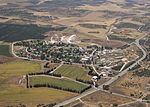Yoav Regional Council

Yoav Regional Council (Hebrew: מועצה אזורית יואב, Mo'atza Azorit Yoav) is a regional council in the Southern District of Israel. It is located near the cities of Kiryat Gat, Kiryat Malakhi and Ashkelon. It was founded in 1952, covering an area of 230,000 dunams (230 km2), with a population of about 5,300. The council is named after Yitzhak Dubnov, who was nicknamed "Yoav", and who fell while defending Negba in the 1947–1949 Palestine war. Operation Yoav and Metzudat Yoav, which is located in the council's area, are also named after him. The council contains two parts which are not contiguous geographically. The main part is bordered on the north by Nahal Sorek Regional Council, on the west by Be'er Tuvia Regional Council and Shafir Regional Council, on the south by Lakhish Regional Council and Kiryat Gat, and on the east by Matte Yehuda Regional Council. The western portion of the council, which includes the kibbutzim Negba and Sde Yoav, is bordered on the north and east by Shafir Regional Council, on the west by Hof Ashkelon Regional Council, and on the west by Lakhish Regional Council.
Excerpt from the Wikipedia article Yoav Regional Council (License: CC BY-SA 3.0, Authors, Images).Yoav Regional Council
Lachish Regional Council
Geographical coordinates (GPS) Address Nearby Places Show on map
Geographical coordinates (GPS)
| Latitude | Longitude |
|---|---|
| N 31.6 ° | E 34.9 ° |
Address
Lachish Regional Council
South District, Israel
Open on Google Maps










